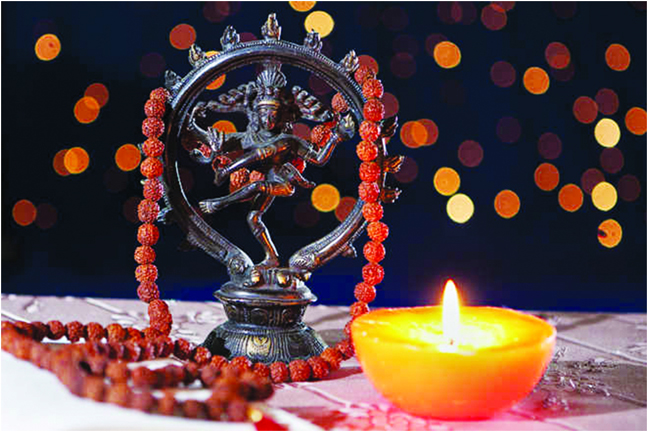Rudraksha, the seed produced by a large evergreen broad-leaved tree of the genus Elaeocarpus. It is abundantly found in the temperate and sub-alpine zone is a pioneer of symbolism in the Shivaism, a major tradition of the Hindu dharma where the believers regard Lord Shiva as the principal deity. Worn around their neck or wrist primarily in the form of Mala by the devotees, it is constituted of two words; Rudra and Aksha, both being of Sanskrit origin. Rudra is the manifested form of Lord Shiva himself and Aksha translates to eyes; meaning, having originated from Lord Shiva’s eyes. Thus, A genuine Rudraksha seed has high significance, scientific properties, yet it is very mysterious and is regarded as highly sacred and precious by the devotees.
Shiva’s tears
As the Legend has it, Lord Shiva had been meditating for thousands of years with his eyes closed. When he opened his eyes, some tears drops fell from his eyes on the ground. Later, these tears grew trees of Rudrakshas. The ardent followers of Shivaism thus regard Rudraksha sacred and to have originated from Lord Shiva’s own tears himself. It is thus believed to have miraculous powers and when possessed it is said bring them closer to Lord Shiva and develop a spiritual connection with him.
To check negative and positive prana
As, Sadhus and Sanyasis were continuously on the move, they could not drink water from just any pool because many times in nature, the water may be poisoned or contaminated in the forest. As the legend goes on, If a person well into spiritual practice; a Sadhu or a Sanyasi held a rudraksha above the water and if the water is good and drinkable, it will go clockwise. Similarly, If it is poisoned, it will go anticlockwise. It is said, if held above any positive pranic substance, it will move in a clockwise direction. If you hold it over any negative pranic substance, it will move in an anti-clockwise direction.
The deity and mantras of different faces
Of all, only 1-14 faced Rudraksha are to be worn by humans. The deity and the Beej Mantra, which is to be chanted while wearing the Rudraksha and also the celestial body associated with, varies from one type of Mukhi appearance to another. For Single faced or Ek Mukhi Rudraksha the Ruling deity is Lord Shiva, Beej Mantra attributed is Om Hreem Namah and the Celestial body is the Sun. For all 21 different kinds, all of the three vary accordingly.
Ek mukhi rudraksha
Single-faced or Ek Mukhi Rudraksha is considered closest to Lord Shiva. When possessed, it is said to bring all kinds of materialistic pleasure and wealth. Though, the most commonly worn by all is Pancha Mukhi or five-faced Rudraksha.
The mala
Traditionally the beads are strung together on a cotton or a silk thread as a Mala. Most commonly the number of beads is 108 plus one. The extra bead is the Bindu. There must always be a Bindu to the Mala, otherwise, the energy becomes cyclical and people who are sensitive may become dizzy. An adult should not wear a Mala with less than 84 beads, plus the Bindu. Any number over that is considered fine.
Chanting and japa yoga
Rudraksha beads are aesthetically perceived to be most effective if in the practice of Japa Yoga, where, the Beej Mantra is repeated verbally or mentally 108 times a day while keeping count on a strand of Rudraksha beads and at the same time submitting oneself to Lord Shiva’s infinite, all-pervasive presence.
An umbrella of energy
The followers of Shivaism believe that the Rudraksha beads create a cocoon of your own energy. For someone who is constantly on the move, Rudraksha is very good support because it creates a cocoon of your own energy. The situation around you may not be conducive to your kind of energy, it will not let you settle down. In ancient times for Sadhus and Sanyasis (sages and preachers), places and situations could trouble them because they were constantly moving. One of the rules for them was never to put their head down in the same place twice.
Faces of rudraksha
Different types of Rudraksha beads have different numbers of segments (or faces) grooved over their surface giving the beads a unique texture. The segment or the face is called ‘Mukhi’ and the identification of a Rudraksha is primarily on a face or Mukhi appearance. The beads range from being one faced to 21 faced and each of them have different aesthetic values attributed to them.
A shield
The Rudraksha beads, as the followers of Shaivism, believe shield against the negative energies. It is possible for some people to use negative energies to cause harm to someone else. The Atharva Veda is all about how to use energies to your advantage and to someone else’s detriment. The Rudraksha beads help to create a cocoon of your own energy shielding the space against negative energies.
Significance for health
The Rudraksha Beads has many scientific properties that hold a lot of significance in Ayurvedic medicine. It is said to lower your blood pressure, calms your nerves, and bring a certain calmness and alertness to your nervous system. It will help them calm down and be more focused.
